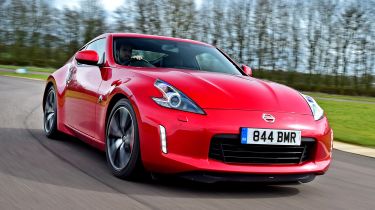New Nissan 370Z 2018 facelift review
Fast, fierce and hairy of chest, the Nissan 370Z feels like a sports car from another era, and that's the problem

The Nissan 370Z offers some much needed old school muscle in a world of small capacity turbocharged sports cars. Light tweaks add appeal, but fail to address the car’s numerous flaws. It remains an involving but challenging car to drive, while the dated infotainment system and questionable cabin feel years behind the competition. It’ll be a shame when the Z finally bites the dust, but that’s not reason enough to buy one.
In 2016, we put the ageing Nissan 370Z up against the (then new) Ford Mustang EcoBoost. Our verdict confirmed that while it had plenty of old-school charm at launch in 2009, the intervening seven years had left Nissan’s sports car feeling rather dated.
Now it’s 2018 and the familiar Z car is nearing a full decade on sale. But despite the 370Z’s advancing years, Nissan isn’t prepared to call it a day just yet. Bosses hope a series of tweaks will offer added appeal in the face of newer rivals; rivals that include everything from the latest hot hatchbacks to the very best two-door coupes.
The external changes may be hard to spot, but the 370Z still looks fresh. The MY18 updates include new door handles, subtly tinted lights, new 19-inch alloy wheels and our car’s striking Infra Red paint. Place the Z alongside a brand-new Audi TT and few would know it’s a 10-year-old design.
Inside, things are a little less modern. Yes, there’s a seven-inch touchscreen sat-nav, but there’s no DAB radio, which seems a little stingy in this day and age. Yes, you can connect your phone, but Apple CarPlay and Android Auto are little more than a pipe dream. The GT model’s Bose stereo is a joy, however, helping drown out the incessant road noise from those big wheels and low profile tyres.
Used - available now

2018 Mazda
6 Saloon
26,134 milesManualPetrol2.0L
Cash £14,063
2020 MINI
Countryman
31,160 milesAutomaticDiesel2.0L
Cash £16,587
2018 BMW
X5
48,752 milesAutomaticDiesel3.0L
Cash £24,606
2020 Volvo
XC60
53,700 milesAutomaticPetrol2.0L
Cash £20,406In terms of mechanical changes, you’d be hard-pushed to notice the new Exedy high-performance clutch in normal use, while the refined suspension does little to transform the firm ride. It’s still quite harsh around town, though things feel more fluid at high speed. While the driving position takes some getting used to, the sports seats are fantastically supportive. It’s just a shame that you still can’t adjust the steering wheel for reach.
The 370Z continues to feel like a physically demanding car to drive. There’s a weight to the controls that is missing in most rivals, with heavy steering and a notchy gearbox. Pushing 324bhp and 363Nm through the rear wheels means the coupe can struggle for traction on wet roads, too.
It isn’t the most tuneful motor and the lack of turbo or superchargers means you have to work the car for its performance. Of course, for keen drivers this will be a pleasure but for those accustomed to downsized four-cylinder turbo engines, it may prove more challenging. The way the revs rise and the speed builds is pleasantly linear, though, and the 370Z is a fast car, whichever way you look at it.
But while the Nissan can compete with rivals when it comes to driver engagement, the high running costs and lofty list prices may be cause for concern. The publicised fuel economy falls nearly 10mpg short of the Ford Mustang’s claim, while the far faster BMW M240i offers much lower CO2 emissions, as well. Residual values are no better than par for the course, either.










